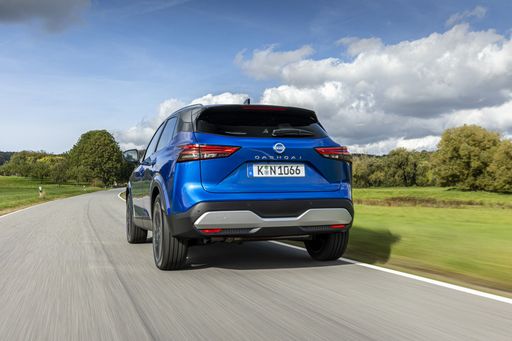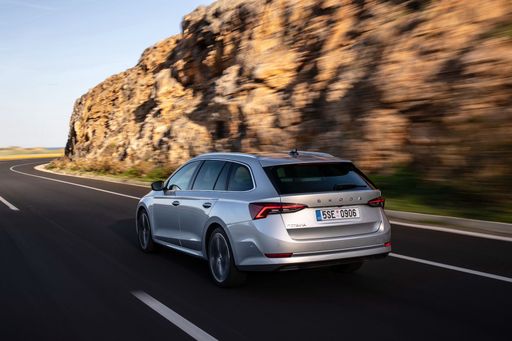In the ever-evolving world of automotive engineering, the competition between compact SUV and wagon segments continues to heat up. In this article, we delve deep into a direct comparison between two popular models: the Nissan Qashqai and the Skoda Octavia Combi. Both vehicles cater to drivers looking for practicality, fuel efficiency, and a host of modern features, but they each bring unique strengths to the table. Let’s explore the technical aspects and innovations that set them apart.
Nissan Qashqai vs Skoda Octavia Combi – Which model is better for everyday use?
Compare performance, boot capacity, efficiency and price at a glance.
Find out which car is the better choice for you – Nissan Qashqai or Skoda Octavia Combi?
Design and Body Type: Where Style Meets Functionality
The Nissan Qashqai embodies the classic SUV aesthetics with a bold and dynamic presence. With a length of 4425 mm, width of 1835 mm, and a height of 1625 mm, it offers a robust silhouette that appeals to urban adventurers. Its 5-door configuration provides easy access for all passengers.
On the other hand, the Skoda Octavia Combi offers a sleek wagon design, stretching 4698 mm in length, 1829 mm in width, and a height ranging from 1455 mm to 1491 mm, depending on the model. Its generous trunk capacity of 640 liters makes it an excellent choice for families or those needing extra cargo space.
Powertrains: Divergent Paths to Performance
Under the hood, the Nissan Qashqai offers a variety of powertrains including petrol options with mild hybrid and full hybrid technology. The Qashqai's power offerings range from 140 HP to an impressive 190 HP. This range allows drivers to choose between agile performance, with acceleration figures of 7.9 seconds (0-100 km/h) for higher trims, and more fuel-efficient options, achieving as low as 5.1 L/100km in consumption.
In contrast, the Skoda Octavia Combi boasts an impressive array of engine choices, including petrol, petrol MHEV, and diesel variants. The power output ranges from a modest 116 HP to a muscular 265 HP. This diversity leads to varying acceleration capabilities, with the sportier versions reaching 0-100 km/h in just 6.5 seconds. Interestingly, the Octavia excels in fuel efficiency as well, with figures reaching as low as 4.4 L/100km in some variants.
Transmission and Drive Options: Flexibility at Your Fingertips
Both models provide drivers with flexible transmission options. The Qashqai offers a choice between manual and automatic transmissions, including a Continuously Variable Transmission (CVT) for smoother acceleration. Available in both front-wheel and all-wheel drive configurations, it caters to a wide range of driving needs.
Similarly, the Skoda Octavia Combi offers manual and automatic transmission options, including a dual-clutch automatic system for rapid shifts. Also available with front-wheel or all-wheel drive, it provides ample choices for varying road conditions and personal preferences.
Innovative Technologies: A Step into the Future
Both vehicles are equipped with advanced technology intended to enhance driver safety and convenience. The Qashqai’s modern interior features the latest infotainment systems with smartphone connectivity, ensuring seamless interaction on the go. Additionally, its safety suite includes various driver-assist features aimed at preventing accidents.
The Octavia Combi does not lag behind either, boasting an equally impressive tech lineup. Its infotainment system is intuitive and user-friendly, enhanced by an array of connectivity options. Skoda’s focus on driver assistance technologies also makes it a formidable competitor, with features designed to enhance both safety and comfort during journeys.
Conclusion: Which One Will You Choose?
Ultimately, the choice between the Nissan Qashqai and the Skoda Octavia Combi boils down to personal preference and specific needs. If you lean towards a stylish, compact SUV with efficient hybrid options, the Qashqai may be your vehicle of choice. However, if you prioritize cargo space and performance while still enjoying great fuel economy, the Octavia Combi stands out with its versatile engine options and storied practicality.
Both vehicles represent a remarkable blend of design, technology, and performance innovation, providing compelling options for today’s savvy drivers. As you ponder your next automotive purchase, consider these attributes closely to determine which car fits your lifestyle best.
Here’s where it gets real: The technical differences in detail
Costs and Efficiency:
When it comes to price and running costs, the biggest differences usually appear. This is often where you see which car fits your budget better in the long run.
Skoda Octavia Combi has a evident advantage in terms of price – it starts at 24400 £, while the Nissan Qashqai costs 29600 £. That’s a price difference of around 5185 £.
Fuel consumption also shows a difference: Skoda Octavia Combi manages with 4.40 L and is therefore slight more efficient than the Nissan Qashqai with 4.50 L. The difference is about 0.10 L per 100 km.
Engine and Performance:
Under the bonnet, it becomes clear which model is tuned for sportiness and which one takes the lead when you hit the accelerator.
When it comes to engine power, the Skoda Octavia Combi has a clearly perceptible edge – offering 265 HP compared to 205 HP. That’s roughly 60 HP more horsepower.
In acceleration from 0 to 100 km/h, the Skoda Octavia Combi is to a small extent quicker – completing the sprint in 6.50 s, while the Nissan Qashqai takes 7.60 s. That’s about 1.10 s faster.
In terms of top speed, the Skoda Octavia Combi performs a bit better – reaching 250 km/h, while the Nissan Qashqai tops out at 206 km/h. The difference is around 44 km/h.
There’s also a difference in torque: Skoda Octavia Combi pulls slightly stronger with 370 Nm compared to 330 Nm. That’s about 40 Nm difference.
Space and Everyday Use:
Beyond pure performance, interior space and usability matter most in daily life. This is where you see which car is more practical and versatile.
Both vehicles offer seating for 5 people.
In curb weight, Skoda Octavia Combi is hardly perceptible lighter – 1366 kg compared to 1420 kg. The difference is around 54 kg.
In terms of boot space, the Skoda Octavia Combi offers evident more room – 640 L compared to 504 L. That’s a difference of about 136 L.
In maximum load capacity, the Skoda Octavia Combi performs a bit better – up to 1700 L, which is about 253 L more than the Nissan Qashqai.
When it comes to payload, Skoda Octavia Combi slight takes the win – 534 kg compared to 520 kg. That’s a difference of about 14 kg.
Who wins the race?
The Skoda Octavia Combi proves to be dominates this comparison and therefore becomes our DriveDuel Champion!
Skoda Octavia Combi is the better all-rounder in this comparison.
 @ Škoda Auto a.s. / Škoda Storyboard
@ Škoda Auto a.s. / Škoda Storyboard
Skoda Octavia Combi
Nissan Qashqai
The Nissan Qashqai blends practical, family-friendly packaging with SUV styling that refuses to shout, making it a sensible and dependable choice for everyday life. It’s comfortable to live with, economical on the road, and neatly equipped enough to feel modern without ever feeling precious — perfect if you want crossover versatility without the drama.
details @ Nissan Motor Corporation
@ Nissan Motor Corporation
 @ Nissan Motor Corporation
@ Nissan Motor Corporation
 @ Nissan Motor Corporation
@ Nissan Motor Corporation
 @ Nissan Motor Corporation
@ Nissan Motor Corporation
 @ Nissan Motor Corporation
@ Nissan Motor Corporation
Skoda Octavia Combi
The Skoda Octavia Combi is the sensible family wagon that somehow turns grocery runs and long trips into a pleasant, unshowy experience — spacious, practical and built like it prefers reliability over flash. With smart touches, clever storage and a cabin that feels grown-up rather than frugal, it’s an easy recommendation for buyers who want maximum utility without sacrificing comfort or style.
details @ Škoda Auto a.s. / Škoda Storyboard
@ Škoda Auto a.s. / Škoda Storyboard
 @ Škoda Auto a.s. / Škoda Storyboard
@ Škoda Auto a.s. / Škoda Storyboard
 @ Škoda Auto a.s. / Škoda Storyboard
@ Škoda Auto a.s. / Škoda Storyboard
 @ Škoda Auto a.s. / Škoda Storyboard
@ Škoda Auto a.s. / Škoda Storyboard
 @ Nissan Motor Corporation
@ Nissan Motor Corporation
|
 @ Škoda Auto a.s. / Škoda Storyboard
@ Škoda Auto a.s. / Škoda Storyboard
|
|
|
|
Costs and Consumption |
|
|---|---|
|
Price
29600 - 39900 £
|
Price
24400 - 42300 £
|
|
Consumption L/100km
4.5 - 6.8 L
|
Consumption L/100km
4.4 - 6.9 L
|
|
Consumption kWh/100km
-
|
Consumption kWh/100km
-
|
|
Electric Range
-
|
Electric Range
-
|
|
Battery Capacity
-
|
Battery Capacity
-
|
|
co2
102 - 154 g/km
|
co2
113 - 157 g/km
|
|
Fuel tank capacity
55 L
|
Fuel tank capacity
45 - 55 L
|
Dimensions and Body |
|
|---|---|
|
Body Type
SUV
|
Body Type
Estate
|
|
Seats
5
|
Seats
5
|
|
Doors
5
|
Doors
5
|
|
Curb weight
1420 - 1665 kg
|
Curb weight
1366 - 1553 kg
|
|
Trunk capacity
479 - 504 L
|
Trunk capacity
640 L
|
|
Length
4425 mm
|
Length
4698 - 4709 mm
|
|
Width
1835 mm
|
Width
1829 mm
|
|
Height
1625 mm
|
Height
1455 - 1468 mm
|
|
Max trunk capacity
1422 - 1447 L
|
Max trunk capacity
1700 L
|
|
Payload
466 - 520 kg
|
Payload
471 - 534 kg
|
Engine and Performance |
|
|---|---|
|
Engine Type
Petrol MHEV, Full Hybrid
|
Engine Type
Petrol, Petrol MHEV, Diesel
|
|
Transmission
Manuel, Automatic
|
Transmission
Automatic, Manuel
|
|
Transmission Detail
Manual Gearbox, CVT, Reduction Gearbox
|
Transmission Detail
Dual-Clutch Automatic, Manual Gearbox
|
|
Drive Type
Front-Wheel Drive, All-Wheel Drive
|
Drive Type
Front-Wheel Drive, All-Wheel Drive
|
|
Power HP
140 - 205 HP
|
Power HP
116 - 265 HP
|
|
Acceleration 0-100km/h
7.6 - 10.2 s
|
Acceleration 0-100km/h
6.5 - 10.7 s
|
|
Max Speed
170 - 206 km/h
|
Max Speed
203 - 250 km/h
|
|
Torque
240 - 330 Nm
|
Torque
220 - 370 Nm
|
|
Number of Cylinders
3 - 4
|
Number of Cylinders
4
|
|
Power kW
103 - 151 kW
|
Power kW
85 - 195 kW
|
|
Engine capacity
1332 - 1498 cm3
|
Engine capacity
1498 - 1984 cm3
|
General |
|
|---|---|
|
Model Year
2025
|
Model Year
2024 - 2025
|
|
CO2 Efficiency Class
E, C
|
CO2 Efficiency Class
E, F, D, C
|
|
Brand
Nissan
|
Brand
Skoda
|
Is the Nissan Qashqai offered with different drivetrains?
Available configurations include Front-Wheel Drive or All-Wheel Drive.
The prices and data displayed are estimates based on German list prices and may vary by country. This information is not legally binding.
